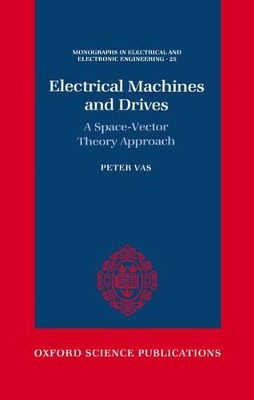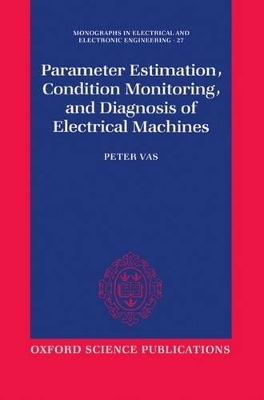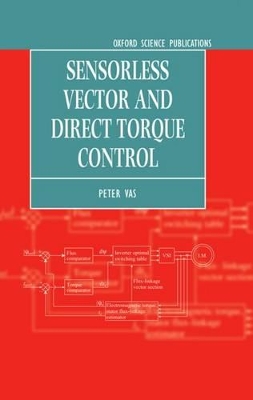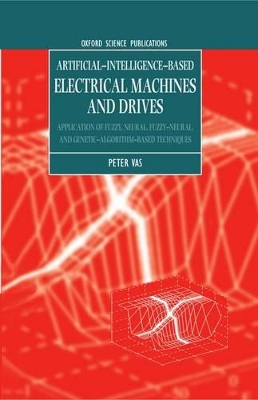Monographs in Electrical and Electronic Engineering
4 primary works
Book 25
The operation and simulation of a.c. and d.c. machines and a large number of variable-speed drives, including some of the most recently introduced modern drives, are discussed here, and a general theory applicable during their steady-state and transient operation is presented. Although the detailed mathematical analysis given relies mainly on space-vector theory, the relationship to other theories, including the matrix theory of generalized machine theory, is also
emphasized. Many of the equations are given in their state-variable or analytical forms so that they can be used directly for computer simulations or for hand calculations.
The novel features of this book include: the `exact' and `simplified' performance analysis of a.c. machines and a large number of variable-speed drives are described; both the large- and small-signal equations are given; the effects of magnetic saturation are incorporated into the different models of smooth-air gap and salient-pole machines; the space-vector model is extended to the double-cage induction machine and the salient-pole synchronous machine; it is demonstrated how all the various
machine models used in the matrix model of electrical machines can be obtained from the simple space-vector model without having to use matrix transformations; a systematic approach is given for the a priori deduction of all the transformations used in generalized machine theory; and permanent-magnet
machines both the surface-mounted and with interior magnets are discussed.
Electrical machines and drives can be used without any prior knowledge of space-vector or other theories; it is aimed at students, teachers, and those researching in industry and universities, who require a deep understanding of the various aspects of the operation and the theories of electrical machines and drives and their simulation.
emphasized. Many of the equations are given in their state-variable or analytical forms so that they can be used directly for computer simulations or for hand calculations.
The novel features of this book include: the `exact' and `simplified' performance analysis of a.c. machines and a large number of variable-speed drives are described; both the large- and small-signal equations are given; the effects of magnetic saturation are incorporated into the different models of smooth-air gap and salient-pole machines; the space-vector model is extended to the double-cage induction machine and the salient-pole synchronous machine; it is demonstrated how all the various
machine models used in the matrix model of electrical machines can be obtained from the simple space-vector model without having to use matrix transformations; a systematic approach is given for the a priori deduction of all the transformations used in generalized machine theory; and permanent-magnet
machines both the surface-mounted and with interior magnets are discussed.
Electrical machines and drives can be used without any prior knowledge of space-vector or other theories; it is aimed at students, teachers, and those researching in industry and universities, who require a deep understanding of the various aspects of the operation and the theories of electrical machines and drives and their simulation.
Book 27
Parameter Estimation, Condition Monitoring, and Diagnosis of Electrical Machines
by Peter Vas
Published 11 February 1993
Condition monitoring of electrical machines and drive systems is a vital factor to achieve efficient and profitable operation of a large variety of industrial processes. Similarly, parameter estimation is important for the machine designer, and invaluable to the operator of modern drives implementing various types of controllers. It is also necessary to know the machine parameters for a number of simulation purposes. The chapters in this volume cover recent trends
and advances in these and other areas, including sections on on-line and off-line parameter estimation of smooth-air-gap and salient-pole electrical machines, their diagnosis and condition monitoring. New real-time monitoring devices, vibroacoustic techniques, and the symptoms and possible causes of
failures of electrical machines are also discussed.
In the book a unified and in-depth physical and mathematical analysis of the various parameter estimators and condition monitoring methods is presented. For this purpose, where possible, space phasor theory is utilized and the most recent and modern developments in the field are incorporated.
and advances in these and other areas, including sections on on-line and off-line parameter estimation of smooth-air-gap and salient-pole electrical machines, their diagnosis and condition monitoring. New real-time monitoring devices, vibroacoustic techniques, and the symptoms and possible causes of
failures of electrical machines are also discussed.
In the book a unified and in-depth physical and mathematical analysis of the various parameter estimators and condition monitoring methods is presented. For this purpose, where possible, space phasor theory is utilized and the most recent and modern developments in the field are incorporated.
Book 42
This is the first comprehensive book on sensorless high performance a.c. drives. It is essential reading for anyone interestred in acquiring a solid background on sensorless torque-controlled drives. It presents a detailed and unified treatment of sensorless vector-controlled and direct-torque controlled drive systems. It also discusses the applications of artificial intelligence to drives. Where possible, space vector theory is used and emphasis is laid on
detailed mathematical and physical analysis.
Sensorless drive schemes for different types of permanent magnet synchronous motors, synchronous reluctance motors, and induction motors are also presented. These include more than twenty vector drives e.g. five types of MRAS-based vector drives, and eleven types of direct-torque-controlled (DTC) drives, e.g. the ABB DTC drive. However, torque-controlled switched reluctance motor drives are also discussed due to their emerging importance. The book also covers various drive applications
using artificial intelligence (fuzzy logic, neural networks, fuzzy-neural networks) and AI-based modelling of electrical machines. Finally, self-commissioning techniques are also discussed.
This is a comprehensive thoroughly up-to-date, and self-contained book suitable for students at various levels, teachers, and industrial readership.
Peter Vas is a Professor at the Department of Engineering at the University of Aberdeen, UK, where he is also the Head of the Intelligent Motion Control Group. His previous books published by Oxford University Press are extensively used worldwide.
detailed mathematical and physical analysis.
Sensorless drive schemes for different types of permanent magnet synchronous motors, synchronous reluctance motors, and induction motors are also presented. These include more than twenty vector drives e.g. five types of MRAS-based vector drives, and eleven types of direct-torque-controlled (DTC) drives, e.g. the ABB DTC drive. However, torque-controlled switched reluctance motor drives are also discussed due to their emerging importance. The book also covers various drive applications
using artificial intelligence (fuzzy logic, neural networks, fuzzy-neural networks) and AI-based modelling of electrical machines. Finally, self-commissioning techniques are also discussed.
This is a comprehensive thoroughly up-to-date, and self-contained book suitable for students at various levels, teachers, and industrial readership.
Peter Vas is a Professor at the Department of Engineering at the University of Aberdeen, UK, where he is also the Head of the Intelligent Motion Control Group. His previous books published by Oxford University Press are extensively used worldwide.
Book 45
Recently artificial-intelligence-based techniques (fuzzy logic, neural networks, fuzzy-neural networks, genetic algorithms, etc) have received increased attention world-wide and at present two industrial drives incorporate some form of artificial intelligence. This is the first comprehensive book which discusses numerous AI applications to electrical machines and drives. The drives considered are: d.c. drives, induction motor drives, synchronous motor drives, and
switched reluctance motor drives. Sensorless drives are also considered. It is essential reading for anyone interested in acquiring a solid background in AI-based electrical machines and drives. It presents a detailed and unified mathematical and physical treatment.
switched reluctance motor drives. Sensorless drives are also considered. It is essential reading for anyone interested in acquiring a solid background in AI-based electrical machines and drives. It presents a detailed and unified mathematical and physical treatment.



